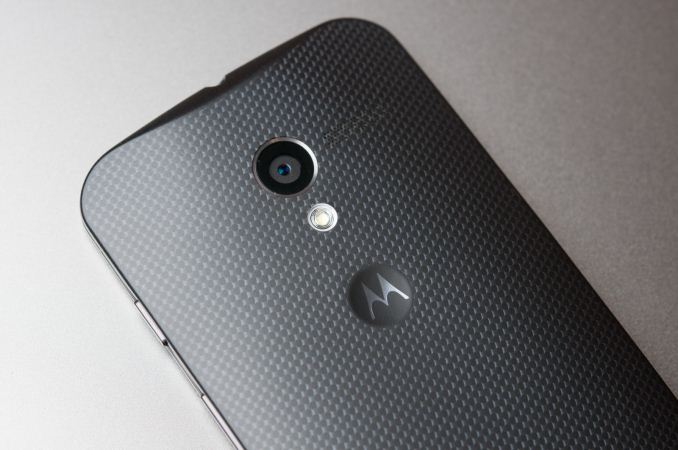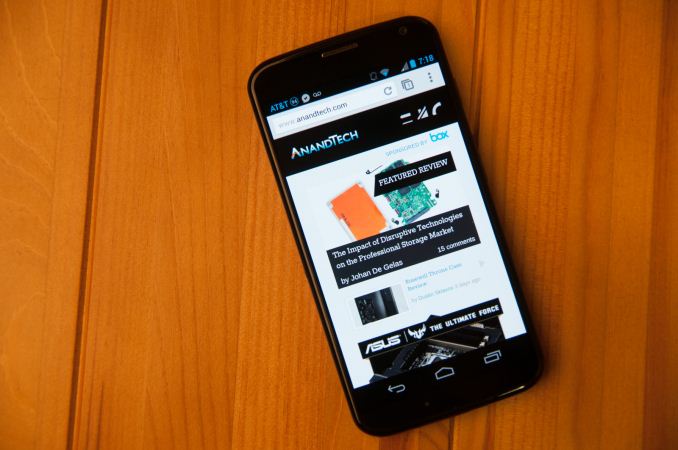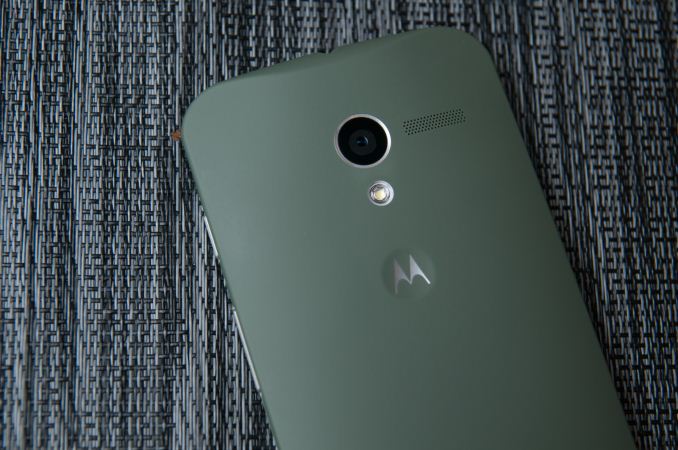Moto X Review
by Brian Klug on August 26, 2013 1:30 PM EST- Posted in
- Smartphones
- Qualcomm
- MSM8960
- Motorola
- Android
- Mobile
- Android 4.2
- Moto X
Final Thoughts & Conclusion
Prior to the Moto X, since being acquired by Google, the execution strategy for Motorola wasn't entirely clear. Google talked about there being a firewall between the two companies, and Motorola described its own situation as being analogous to YouTube's. The first result of that strategy is effectively a re-launch of the mobile part of Motorola, and its first device, the Moto X.
I finish the Moto X review feeling very differently about the device than I did initially, in a positive way. I have to admit that I went into the Moto X review very skeptical for a few reasons. Initially the amount of hype surrounding the Moto X was somewhat off-putting, as if many expected the Moto X to instantly eclipse Nexus and all other Android phones entirely because of the Google involvement. The second thing was the weird octacore messaging and dilution of the word "core" even further, and the SoC choice itself, but I understand better now the choices behind that platform and messaging. While there's still no getting around the fact that having a dual core SoC in a world of quad core devices is difficult to explain away, in this case having 8960Pro with two CPU cores helps Motorola run them at higher frequency more of the time versus the throttling that goes on with current 28nm LP quad core parts. The other performance aspect is obviously how using F2FS helps the Moto X have comparatively very fast random read and write performance, and storage I/O will start to become a big consideration for performance.
The features Motorola has enabled through the addition of a TI MSP430 for sensor fusion (its contextual awareness processor) and TI C55x family DSP (its natural language processor) are indeed major unique and novel features for the Moto X. Active display is probably my favorite feature out of the things enabled by the X8 Mobile Computing System and the combination of these two extra TI components (err... "cores"). It's useful for quickly being able to just glance at what's new or why your phone vibrated in your pocket, or if it even vibrated at all. It also is perhaps one of the best uses of AMOLED I've seen, for doing something other than just displaying a clock and battery status when the phone is in standby.
The other two features are novel but not something I can't live without. Touchless control works, but I still think that if you're within speaking distance of your Moto X you probably could just pick up the phone and use it. The upside is that the feature doesn't affect battery life (I tested with it enabled and disabled) and can be convenient, the downside is that activate on voice still has some false positives. Likewise, the camera activation gesture definitely has some false positive issues and occasionally presents me with a gallery page full of photos of the inside of my pocket. Launching the camera that way is more natural than I thought it would be, so I still use it, but occasional activation in your pocket is just something to be wary of.
Including a primarily stock UI is also a huge step in the right direction, and perhaps the most positive result of the Google interaction. With Android 4.x, the platform really doesn't need much custom tailoring and smoothing over except for the camera UI. Being able to use the stock UI makes the Moto X feel almost like the Google Play edition HTC One and SGS4 I was used to before switching to the Moto X. The ability to use the stock UI will be a huge selling point for users who are on CDMA networks (and refuse or unable to switch) and can't use a Nexus or GPe phone.
The Moto X is an interesting flagship product thanks in part to its smaller size and shape. There's a market out there for a flagship smartphone that isn't gigantic, and at present it's really served almost entirely by the iPhone. While I have gotten gradually used to larger and larger phones, I have to admit it is refreshing to use the Moto X and I have an easier time doing one-handed swipe typing on the Android keyboard and navigating around apps. The rounded shape and lack of cheap-feeling glossy plastic really helps the Moto X feel like a premium smartphone.
The Moto X is without a doubt the closest thing we have in the Android handset space to a smaller flagship device - one that isn't positioned as a midrange phone against a larger hero device. I've described the Moto X as being on the smaller side, but it still includes a relatively large 4.7-inch display, the Moto X just wastes less of the space around that display.
While Motorola suffered a few hiccups with Moto Maker and getting our Moto Xes out on time, I have no doubt the build-your-own customization aspect of the device will be very popular. I'm very pleased with how my device turned out, and having something which looks different, and I specified, really does make me want to use it more. I'm still more excited about the upcoming wood-backed options as well, I just wish they were available at launch and not coming some time in Q4 2013.
The camera on the Moto X nails it on paper – it's a comparively big sensor, with 1.4µm pixels instead of the 1.1µm kind that has been the industry trend, and F/2.4 optics. In practice however the Moto X camera has somewhat bimodal behavior – it can be good, it also can be bad, and a lot of that comes from the clear pixel color filter array which trades off some resolution for sensitivity and introduces color artifacts. In bright scenes I saw some great results from the Moto X camera, but indoors and in darker scenarios the device seems to use different processing that changes behavior entirely. Motorola deserves credit for doing something different, however.
The Moto X does a lot of things right – the size, shape, stock UI, customization. I enjoy using the Moto X a lot more than I thought I would, and think Motorola hit a home run with the Moto X in the size and shape department. Its only Achilles heel is its price, which comes in at $199 on a 2 year contract and $579 off contract at AT&T. There's still no word on Google Play edition or Developer Edition pricing, but I expect they'll be around the same. I still feel like that's too high considering the platform choices, although I expect the Moto X will come down in price pretty rapidly once MSM8974 phones start hitting the market. At the right price the Moto X could be a very big deal, almost disruptive. It's just a matter of getting it there.













105 Comments
View All Comments
cheinonen - Tuesday, August 27, 2013 - link
4K is a marketing term thanks to Sony and everyone else. In the actual definition, 4K doesn't have a set aspect ratio. A film mastered at 4K is 4096 pixels wide, and the height is totally dependent on the aspect ratio. If it is flat, then it's 4096/1.85 pixels high. If it is scope, it's 4096/2.39 pixels high.Sony, LG, Samsung and everyone else are using 4K to mean 3840x2160 pixels for the home. UltraHD is the technical name now (with Rec. 2020) but that was finalized after the 4K horse had already left the barn.
Impulses - Tuesday, August 27, 2013 - link
Kind of ironic, I bet UltraHD sounds catchier or at least more descriptive to the layman... 4K's definitely spreading fast tho.rcpinheiro - Tuesday, August 27, 2013 - link
You're right, marketing teams are using "4K" incorrectly but at least here in AnandTech I expected writers to use standard names correctly.4K is a standard created by Digital Cinema Initiative, it uses JPEG2000 compression and bitrates upto 250Mbps.
(I agree with use Impulses, for the layperson "Ultra HD" sounds better than the techy term "4K")
Krysto - Tuesday, August 27, 2013 - link
It is a marketing term - an unfortunate one. Because I don't want them to ruin the ratios when they get to that resolution. They should keep the UHD resolution to scale perfectly from 1080p (4x the pixels). If some OEM's decide that to have "real 4k" they need to make the resolution 4kx2k, that would really SUCK!.mike55 - Monday, August 26, 2013 - link
Brian, what are your reasons for preferring some LCDs over Samsung's OLED panels?Doh! - Monday, August 26, 2013 - link
I could tell you couple reasons as a long time user of Sammy's OLED panel in my phone but I'm not Brian. Having said that, burn-in is one of the issues for many OLED panels.Impulses - Tuesday, August 27, 2013 - link
For me, the over saturated colors IMO, not the best for viewing photos, and I've started to view a lot of non-smartphone photos on my phone now that my camera has Wifi/NFC (most current gen Panasonic/Sony do, even Canon's newest DSLR, the 70D).mike55 - Tuesday, August 27, 2013 - link
It's unfortunate that a lot of manufactures seem to disregard the sRGB color space when it comes to implementing OLED panels in their devices. I'm not sure I would've bought my GS4 if it weren't for the "movie" display mode that gets it somewhat close to the sRGB gamut.comomolo - Tuesday, August 27, 2013 - link
I'm not Brian either, but I don't care too much about color accuracy on a phone. I do care about something the N9 invented and amazingly nobody else still copied it yet: permanent display of the time and notification icons. That can't be done efficiently with an LCD and its so useful I simply can't understand it took that long to come to Android. Even this MotoX isn't implementing it fully. You still can't just take a look at the phone on the table and know the time or if some new message is in, if there's a missed call or text, etc.I haven't seen a single burned pixel on an AMOLED screen (been using Samsung phones for a while, and lots of friends too). Regarding color accuracy, I don't believe the technology itself is responsible for that, but factory calibration. Android might/should allow for user calibration (the same we do with monitors) and make this a moot point.
Heartdisease - Wednesday, August 28, 2013 - link
Well that's strange. My Galaxy Nexus has had burn in for quite awhile and it is getting more pronounced. Turn any amoled 180* from your normal orientation and look where the on screen buttons were. If you don't see it on the rest of the screen your blind.